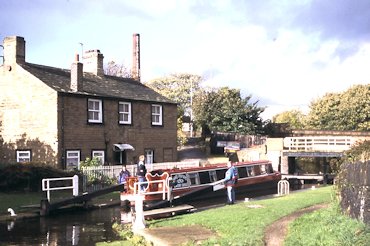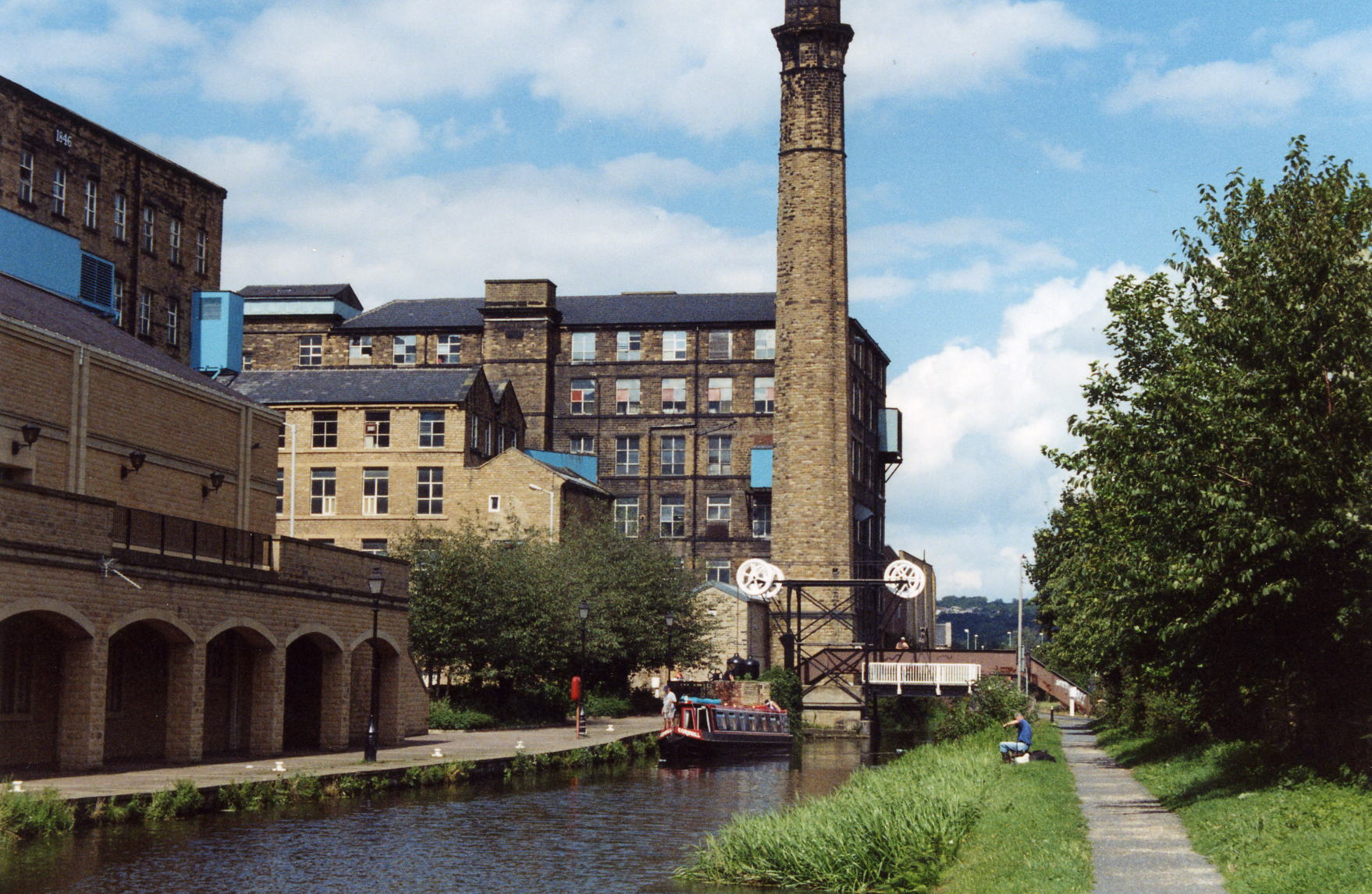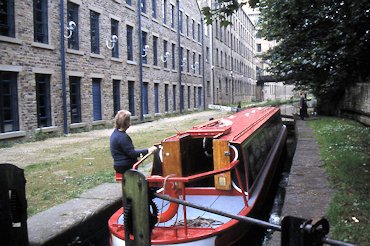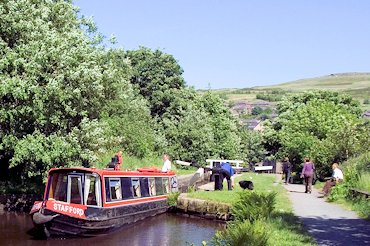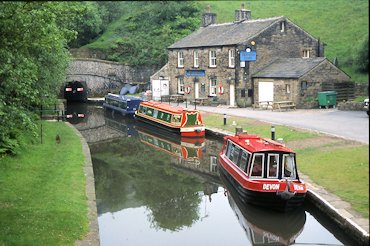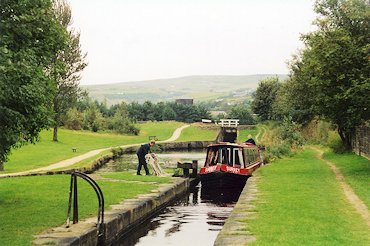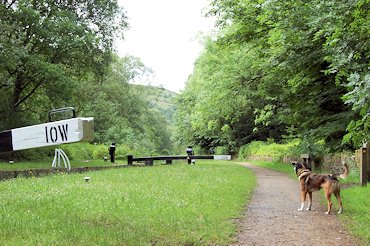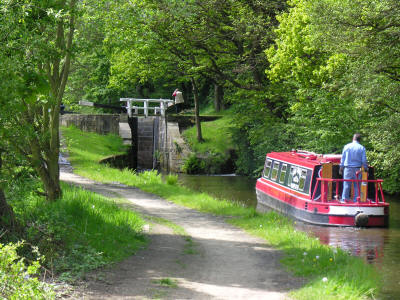
You enter the Huddersfield Narrow by going, Harry Potter-like, though a concrete wall. That is, you go under a road which had been widened while the canal was closed, leaving only a pipe for the water. The reinstatement of a bridge here by the then County Council was one of many such blockage removals which enabled the canal to be reopened.
Straight away you pass an old warehouse and reach the first
of the 42 locks which will take you up to the moors. You are
going through the University here. Pass straight through the
head of the next lock chamber and into a new cutting which gets
you under a factory, through two new locks, and emerge beside
another college which takes full advantage of its city centre
canalside. Stop if you need it at the nation's biggest chandlery
chain (B&Q) then go under a rather elemental lattice railway
viaduct and into an unfrequented back part of the town. You
emerge in Milnsbridge, with a succession of determined mill
conversions and new buildings. Moor at the wide and explore
quite a useful compact high street. The locks are close together
as you climb rapidly up the Colne Valley to Golcar, which has an
attractive tight-bended aqueduct taking the canal onto the other
side of the river. There's a small museum of weaving life here.
Across the widening valley bottom is Titanic Mill,
everything its name implies and converted into super-posh flats
- sorry, apartments. You go on through pretty woodland, and past
not-yet-restored mills. Don't neglect the steep walk across
fields to the Olive Branch. In a while you get to Slaithwaite,
which gave the restorers a real headache because the canal had
been comprehensively eliminated. The measure of their success is
how well the canal seems to fit into the town.
Slaithwaite
make a good overnight mooring. More woods and enticing views of
the hills bring you to the bottom of the Marsden flight. These
last twelve locks take you quickly up above the town to the
summit. You need to moor here till it's time for your tunnel
passage, so walk down into the town and find useful shops and a
good choice of pubs plus one by the canal at the railway
station, and the Tunnel End. Visit also the Visitor Centre, with
excellent material and audio-visuals on the canal, building the
tunnel, packhorses before the canal, and centuries of social
history.
Now comes the highlight of your journey.
Accompanied by a knowledgeable person from Canal & River Trust,
plunge into the inky depths below Marsden Moor. Soon the tunnel
bore opens out into naked rock, and your guide will show you the
marks where the navvies bored hole by muscle power ready for
blasting of the rock. After a couple of hours you emerge in
Lancashire. The Diggle Hotel beckons, then you sweep down the
flight, with extensive views, before passing under an amazing
viaduct and over Old Sag, a little aqueduct, and arriving in
Uppermill. This is worth a decent stop, with shops, pubs and in
interesting museum of local life.
The canal now drops away
through a mixture of greenery, new development and sites whose
owners haven't yet seen the light; always changing and always
interesting. Greenfield makes a good stop. Rather suddenly you
arrive in Stalybridge, a town not without its problems but also
with real charm. There's a Tesco right by the canal, and streets
of shops nearby, criss-crossing the canal, large parts of which
have been rebuilt from scratch.
Below Stalybridge there is a
short rather grotty stretch which perks up below the bottom lock
at the invisible junction with the Ashton Canal, and leads
through a tunnel under an ASDA to Portland Basin, which has a
fascinating and extensive museum in a reconstructed warehouse
and a candidate for the most graceful footbridge anywhere on the
canals. The Huddersfield Narrow packs 74 locks into 20 miles and
reaches the highest point on any English waterway, with the
longest tunnel. It makes an unforgettable journey.
Boating on the Huddersfield canals
The Huddersfield Broad is like the Calder & Hebble without the handspikes. Don't lift the gate paddles too soon as you go up, and keep away from the cill as you go down. There is neat lift bridge which you work with a CRT key, and can have fun with in rush hour.
The Huddersfield Narrow is freely available from either end up to points some way below each side of the summit - Lock 32W and Uppermill. Between these points traffic is controlled to limit demands on water and staff time. Passage over the summit and through Standedge Tunnel is available on Monday, Wednesday and Friday, and must be booked (0303 0404040). Limited passage may also be available to boats wishing to moor at Marsden without going through the tunnel. Water supply is restricted, and boats are asked to keep at least two locks between them, to give time for recovery.
Click to see CRT info for the Huddersfield Narrow Canal and Standedge Tunnel
The Huddersfield Canal - a little history
If
a large part of the attraction of the Huddersfield Narrow to
leisure boaters is its sheer improbability, its ill-chosen route
meant it was the most challenged of the three trans-Pennine
canals (or four if one counts the High Peak Tramway linking the
Cromford Canal with the Peak Forest).
The route was chosen
not as the best route across the Pennines, but because the
Ashton Canal wanted access to Yorkshire. It became inevitable to
cross Marsden Moor, but in order to obtain water in crossing the
watershed it was necessary to go across at a lower level, hence
the tunnel. The canal itself was built quickly enough, completed
by 1799, only four years after the Act. The tunnel took another
twelve years, eating money and lives.
To get the Act against
opposition from mill owners, the company had to agree to take no
water from the rivers beside which the canal was built. Thus it
was fed entirely from reservoirs.
So the canal opened fully
in 1811. It faced difficulties over the change of gauge at
Huddersfield, and short narrow boats were built to avoid
transhipment but of course could carry less. Competition from
other canals affected revenue. Then by the early 1840s the
railways made their move, and as early as 1845 the canal had
sold out. Traffic on the canal held up well for most of the
century, but became concentrated at the ends; traffic through
Standedge had finished by as early as 1905. By the end of the
First World War there was little moving, and the Huddersfield
narrow fell victim to the notorious LMS abandonment in 1944.
So the HNC was one of the canals which was nationalised in 1948
because it was part of a railway. It was maintained as a water
channel, and the locks were gradually filled in and the bridges
dropped. It was in a pitiful state when in 1974 the people who
had achieved the reopening of the Ashton and lower Peak Forest
looked around for something to do.
A stunning campaign was
run by the Huddersfield Canal Society. Hearts and minds were
converted, and the money started to follow. British Waterways
gradually played a more active part, going way beyond what they
were supposed to do - maintain the canal strictly at lowest cost
as a water channel. Since the canal reopened in 2001, further
huge steps have been made in improving the locks and reducing
leaks. There are still challenges ahead, not least the legacy of
that early concession, not to use river water. But the canal has
definitely come back to robust life; a miracle.
Further reading
Pennine Dreams - The Story of
the Huddersfield Narrow Canal by Keith Gibson
The
Huddersfield Narrow Canal: Two Hundred Years in the Life of a
Pennine Waterway by Keith Gibson and David Finnis



